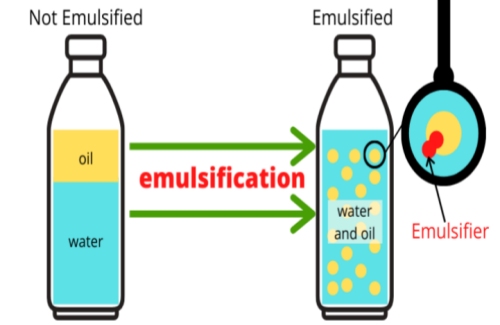Why It Is Necessary to Integrate an Emulsifier in Food for Ideal Preference and Top Quality
Emulsifiers play a vital function in food manufacturing by guaranteeing the secure mixing of immiscible fluids, such as oil and water. They decrease interfacial tension, which stops the separation of active ingredients and adds to an uniform structure. This not only improves mouthfeel but likewise affects flavor perception. Understanding the necessity of emulsifiers reveals much deeper insights into their feature and importance in cooking applications. What implications does this have for food innovation and consumer choices?
Recognizing Emulsifiers: The Fundamentals
Emulsifiers play a crucial function in food science, functioning as representatives that facilitate the mixing of 2 immiscible fluids, such as oil and water. These substances have both hydrophilic (water-attracting) and hydrophobic (water-repelling) homes, which allow them to support solutions. Common emulsifiers include lecithin, found in egg yolks and soybeans, and mono- and diglycerides, stemmed from fats.
The Scientific research Behind Emulsification
When two immiscible liquids are incorporated, the process of emulsification comes to be essential for attaining a stable mix. Emulsification involves distributing one fluid within another, normally oil in water or vice versa. This procedure happens via mechanical anxiety, which damages the larger droplets right into smaller ones, thus boosting the area. Without the visibility of emulsifiers, these droplets would coalesce, leading to splitting up.
Emulsifiers are particles with hydrophilic (water-attracting) and hydrophobic (water-repelling) residential properties. Their distinct structure enables them to reduce the interfacial stress in between the two immiscible fluids, stabilizing the solution. This stabilization protects against separation and enhances the harmony of structure and flavor. The communications at the molecular degree are vital for maintaining the stability of the emulsion, making sure that food preserve their desired consistency and preference. Recognizing this scientific research is considerable for food researchers and makers in developing high-grade food.
Kinds Of Emulsifiers Made Use Of in Food
The kinds of emulsifiers made use of in food can be generally classified right into artificial and natural ranges. Typical food emulsifiers, such as lecithin and mono- and diglycerides, play a crucial role in enhancing food stability and texture. Recognizing these distinctions is necessary for valuing just how emulsifiers add to the total quality of foodstuff.
Synthetic vs. natural Emulsifiers
While both artificial and natural emulsifiers offer the vital function of stabilizing mixtures in food products, their origins and attributes differ considerably. All-natural emulsifiers, obtained from plant or animal resources, include lecithin, casein, and specific gum tissues. They are typically perceived as healthier options, attracting consumers looking for clean-label items. On the other hand, artificial emulsifiers, such as mono- and diglycerides, are chemically engineered and might supply enhanced security and functionality in a larger range of applications. These synthetic alternatives can be more cost-efficient and give regular high quality. They may stimulate uncertainty amongst health-conscious customers. Ultimately, the selection between all-natural and artificial emulsifiers depends on the preferred top qualities of the foodstuff, consisting of appearance, taste, and shelf-life stability.
Common Food Emulsifiers
Emulsifiers play an important duty in the food sector, guaranteeing the stability and appearance of various products. Usual food emulsifiers consist of lecithin, mono- and diglycerides, and polysorbates. Emulsifier In Food. Lecithin, originated from sources like soybeans and egg yolks, is widely made use of in baked items and chocolates. Mono- and diglycerides, commonly acquired from vegetable oils, improve the creaminess of margarine and gelato. Polysorbates, synthetic emulsifiers, are often located in salad dressings and sauces, advertising a smooth uniformity. Other emulsifiers such as xanthan gum and guar gum tissue, both natural thickeners, also contribute to the wanted texture in various food products. Each emulsifier type offers specific purposes, adding to the total quality and appeal of food things

Duty in Food Stability
Food security is greatly affected by the types of emulsifiers made use of, which assist protect against the separation of active ingredients in various formulas. Emulsifiers such as lecithin, mono- and diglycerides, and polysorbates play necessary duties in preserving the uniformity of items like dressings, sauces, and ice creams. Lecithin, originated from soy or egg yolk, is particularly efficient as a result of its natural homes, while mono- and diglycerides boost texture and rack life. Polysorbates, on the other hand, improve the security of oil-in-water emulsions, making them perfect for baked items. The option of emulsifier depends upon the specific food application and preferred attributes, making sure that products remain secure, appealing, and of excellent quality throughout their desired service life.
How Emulsifiers Improve Texture and Mouthfeel
Enhancing the sensory experience of food, emulsifiers play a vital duty in improving texture and mouthfeel. These materials assist in the uniform distribution of active ingredients, enabling a smoother and creamier uniformity in items such as dressings, sauces, and ice lotions. By supporting mixes of oil and water, emulsifiers stop splitting up, resulting in a natural texture that enhances the total consuming experience.
Emulsifiers can customize the thickness of food products, adding to a preferable density or creaminess. This modification of texture can influence how food really feels in the mouth, impacting satisfaction and satisfaction. Additionally, by creating a secure emulsion, emulsifiers aid preserve the integrity of the item, making sure that the designated mouthfeel is continually provided in time. In general, the application of emulsifiers is important for achieving the best appearance and mouthfeel, eventually raising the high quality of food.
The Function of Emulsifiers in Taste Improvement
Flavor enhancement in culinary applications commonly depends upon the effective use emulsifiers. These compounds help with the blending of water and oil, permitting the even distribution of flavor substances within food items. By producing secure emulsions, emulsifiers aid to encapsulate and release unstable tastes, enhancing the overall sensory experience.
Additionally, emulsifiers can improve the understanding of preference by affecting the mouthfeel and structure of recipes. A smoother, extra natural product can cause an increased assumption of flavors, making them extra satisfying and noticable. Emulsifiers can shield sensitive tastes from destruction, making certain that they remain intact throughout processing and storage.
Emulsifiers in Popular Food Products
How do emulsifiers contribute to the texture and stability of prominent food? Emulsifiers play an important role in numerous widely eaten things. In salad dressings, they guarantee a smooth blend of oil and vinegar, protecting against splitting up and enhancing mouthfeel. In gelato, emulsifiers develop a luscious appearance by maintaining air bubbles, resulting in a abundant and indulgent item. Baked items, such as bread and cakes, gain from emulsifiers by improving quantity and crumb structure, bring about a lighter and a lot more appealing appearance. In addition, mayo counts on emulsifiers to preserve its you can check here thick consistency and protect against oil separation. Margarine and spreads likewise make use of emulsifiers to accomplish a spreadable appearance while preserving stability. These examples highlight the significant effect of emulsifiers on the high quality and satisfaction of daily foodstuff, emphasizing their value in modern-day food formulation.
The Future of Emulsifiers in Food Innovation
The future of emulsifiers in food innovation is noted by considerable developments in modern technology, paving the way for brand-new formulas. In addition, the need for much healthier emulsifier choices is increasing, prompting researchers to explore plant-based and natural alternatives. Sustainable sourcing practices are also becoming necessary, as customers significantly prioritize ecological responsibility in their food choices.
Innovations in Emulsifier Modern Technology
As researchers proceed to discover the molecular details of emulsifiers, substantial advancements are emerging that assurance to change food innovation. Current advancements concentrate on producing extra flexible and efficient emulsifiers that enhance structure, stability, and taste in various food. Advancements in biopolymer-based emulsifiers are gaining grip, offering improved sustainability and performance over typical options. official source Furthermore, developments in nanotechnology are allowing the design of emulsifiers at the molecular level, which can cause finer emulsions and enhanced sensory experiences. These technological breakthroughs are not only improving product quality yet additionally increasing the array of applications for emulsifiers in the food sector. As these technologies unfold, they are expected to redefine culinary possibilities and customer preferences in the future.
Much Healthier Emulsifier Alternatives
While standard emulsifiers have played an important function in food manufacturing, there is an expanding need for healthier options that align with customer preferences for clean labels and all-natural components. Developments in plant-based emulsifiers, such as those derived from sunflower, flaxseed, and soy, have acquired appeal because of their perceived wellness benefits. These choices commonly consist of less ingredients and supply performance comparable to artificial emulsifiers. In addition, components like aquafaba, the liquid from prepared chickpeas, have arised as flexible emulsifying agents, appealing to vegan and health-conscious customers. Emulsifier In Food. The change in the direction of these healthier emulsifiers not only improves the allure of foodstuff but likewise supports the fad of openness in active ingredient sourcing, inevitably promoting customer depend on and contentment

Lasting Sourcing Practices
Lasting sourcing methods are coming to be increasingly crucial in the recommended you read development of emulsifiers, showing a more comprehensive dedication to ecological duty within the food sector. Manufacturers are currently prioritizing using eco-friendly resources, such as plant-based active ingredients, which decreases the carbon impact connected with traditional emulsifiers. This shift not only supports biodiversity however additionally promotes honest farming techniques that benefit local neighborhoods. Furthermore, innovations in modern technology enable the removal and processing of emulsifiers with lowered environmental impact. By taking on sustainable sourcing, firms boost their brand picture while meeting customer need for openness and eco-friendliness. As the food industry continues to advance, the integration of sustainable emulsifiers will play an important role in forming future innovations, guaranteeing an equilibrium between quality and ecological stewardship.
Often Asked Questions
Are Emulsifiers Safe for Individuals With Food Allergies?

Can Emulsifiers Affect the Nutritional Worth of Food?
Emulsifiers can influence the dietary value of food by boosting nutrient absorption or potentially changing the bioavailability of specific compounds. Their impacts vary extensively depending on the kind of emulsifier and the general food formula.
Just How Do Emulsifiers Impact Service Life of Products?
Emulsifiers enhance the service life of products by stabilizing blends, avoiding separation, and reducing putridity. This security helps keep appearance and taste with time, eventually making sure food continues to be attractive and risk-free for longer durations.
What Prevail Natural Emulsifiers Located in Home Kitchens?
Common natural emulsifiers located in home cooking areas consist of egg yolks, soy, mustard, and honey lecithin. These active ingredients help stabilize blends by reducing surface stress in between oil and water, boosting appearance and uniformity in numerous dishes.
Are There Any Type Of Interest In Artificial Emulsifiers in Food?
Concerns relating to synthetic emulsifiers in food consist of prospective digestion concerns, inflammatory actions, and links to weight problems. Some studies recommend these additives may interrupt digestive tract microbiota, increasing questions about their lasting impacts on health and well-being.
Typical food emulsifiers, such as lecithin and mono- and diglycerides, play an essential role in enhancing food security and structure. Emulsifiers play a vital duty in the food sector, making sure the security and texture of numerous items - Emulsifier In Food. Various other emulsifiers such as xanthan gum tissue and guar gum tissue, both all-natural thickeners, additionally add to the preferred structure in numerous food products. Current developments focus on producing a lot more reliable and flexible emulsifiers that boost texture, security, and flavor in numerous food items. Emulsifiers can pose risks for people with food allergic reactions, as some emulsifiers are obtained from allergens like soy or eggs